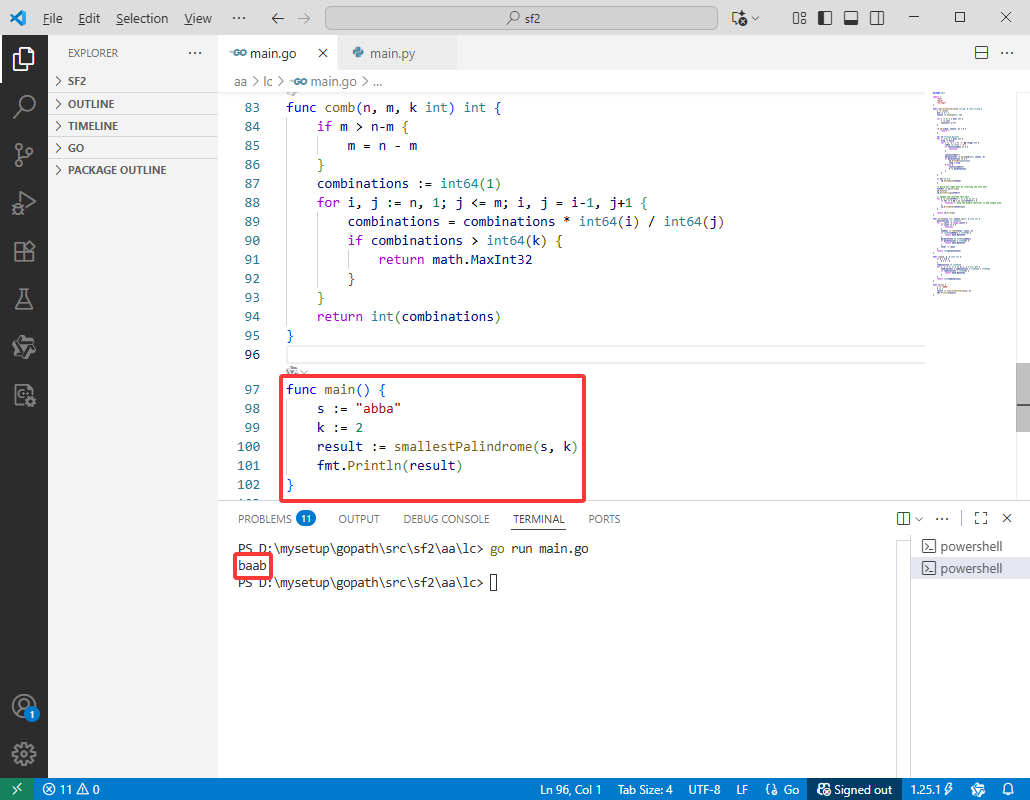2025-10-06:最小回文排列Ⅱ。用go语言,给定一个本身就是回文的字符串 s 和一个整数 k。把 s 的字符重新排列,找出
【摘要】 2025-10-06:最小回文排列Ⅱ。用go语言,给定一个本身就是回文的字符串 s 和一个整数 k。把 s 的字符重新排列,找出所有不同且仍然是回文的字符串,并按字典序从小到大排序。返回这个有序序列中的第 k 个字符串;如果这样的不同回文排列不足 k 个,则返回空字符串。术语说明(便于理解):回文:从左到右读与从右到左读相同的字符串。排列:对原字符串中字符位置进行重新组合得到的新字符串。唯一...
2025-10-06:最小回文排列Ⅱ。用go语言,给定一个本身就是回文的字符串 s 和一个整数 k。把 s 的字符重新排列,找出所有不同且仍然是回文的字符串,并按字典序从小到大排序。返回这个有序序列中的第 k 个字符串;如果这样的不同回文排列不足 k 个,则返回空字符串。
术语说明(便于理解):
-
回文:从左到右读与从右到左读相同的字符串。
-
排列:对原字符串中字符位置进行重新组合得到的新字符串。
-
唯一性:不同的重排如果生成了相同的回文结果,只计为一个。
-
字典序比较:逐位比较字符,首个不同处字符较小的一侧字典序更小;若一个字符串是另一个的前缀,则更短的那个更小。
1 <= s.length <= 10000。
s 由小写英文字母组成。
保证 s 是回文字符串。
1 <= k <= 1000000。
输入: s = “abba”, k = 2。
输出: “baab”。
解释:
“abba” 的两个不同的回文排列是 “abba” 和 “baab”。
按字典序,“abba” 位于 “baab” 之前。由于 k = 2,输出为 “baab”。
题目来自力扣3518。
解决过程
1. 预处理字符频率统计
- 计算字符串长度
n和中间位置mid = n/2 - 创建一个长度为26的数组
counts来统计左半部分每个字符的出现次数 - 只遍历左半部分字符(索引
0到mid-1),统计每个字符的频率
2. 可行性检查
- 调用
perm函数计算左半部分所有可能的排列数量 - 如果排列数量小于
k,说明没有足够的回文排列,直接返回空字符串
3. 构造左半部分字符串
这是核心的贪心构造过程:
- 从左到右逐个位置确定字符
- 对于每个位置,按字典序从 ‘a’ 到 ‘z’ 尝试每个可能的字符:
- 如果该字符在
counts中还有剩余次数,暂时选择它 - 计算选择当前字符后,剩余位置的所有排列数量:
- 从
counts中减少当前字符的计数 - 调用
perm计算剩余字符的排列数
- 从
- 如果排列数
>= k:确定选择当前字符,继续处理下一个位置 - 如果排列数
< k:恢复字符计数,k减去这个排列数,尝试下一个字符
- 如果该字符在
4. 构建完整回文
- 左半部分构造完成后:
- 如果是奇数长度字符串,在中间添加原字符串中间位置的字符
- 将左半部分反转后拼接到右侧,形成完整的回文
辅助函数说明
perm 函数
计算给定字符频率下的排列数:
- 输入:剩余位置数
total,字符频率数组counts,阈值k - 计算多重集合的排列数公式:
total! / (count1! × count2! × ...) - 使用组合数相乘的方式计算,避免直接计算阶乘的溢出
- 如果中间结果超过
k,提前返回最大值(优化)
comb 函数
计算组合数 C(n, m):
- 使用公式:C(n, m) = n×(n-1)×…×(n-m+1) / m!
- 采用迭代计算,每次乘一个数除一个数,避免大数运算
- 如果中间结果超过
k,提前返回最大值
示例分析
对于 s = "abba", k = 2:
- 左半部分字符:‘a’, ‘b’,频率:a:1, b:1
- 可能的左半部分排列:[“ab”, “ba”]
- 对应完整回文:[“abba”, “baab”]
- 第2个是 “baab”
复杂度分析
时间复杂度
- 字符频率统计:O(n)
- 可行性检查:O(26 × n) 最坏情况
- 构造过程:每个位置最多尝试26个字符,每次尝试需要计算排列数,最坏 O(26² × n)
- 总体:O(26² × n) = O(676n) ≈ O(n)(因为26是常数)
额外空间复杂度
- 字符频率数组:O(26) = O(1)
- 字符串构建器:O(n)
- 递归调用栈:O(1)(没有递归)
- 总体:O(n)(主要用于存储结果字符串)
这个算法通过贪心构造和组合数学计算,高效地找到了第k小的回文排列。
Go完整代码如下:
package main
import (
"fmt"
"math"
"strings"
)
func smallestPalindrome(s string, k int) string {
n := len(s)
mid := n / 2
counts := make([]int, 26)
for i := 0; i < mid; i++ {
c := s[i]
counts[c-'a']++
}
if perm(mid, counts, k) < k {
return ""
}
var sb strings.Builder
for i := 0; i < mid; i++ {
flag := false
for c := 'a'; c <= 'z' && !flag; c++ {
index := int(c - 'a')
if counts[index] == 0 {
continue
}
counts[index]--
permutations := perm(mid-i-1, counts, k)
if permutations >= k {
sb.WriteByte(byte(c))
flag = true
} else {
counts[index]++
k -= permutations
}
}
}
if n%2 != 0 {
sb.WriteByte(s[mid])
}
// Build the right half by reversing the left half
leftStr := sb.String()
sb.Reset()
sb.WriteString(leftStr)
// Append the reversed left half
for i := len(leftStr) - 1; i >= 0; i-- {
if n%2 != 0 && i == len(leftStr)-1 {
continue // Skip the middle character in odd length case
}
sb.WriteByte(leftStr[i])
}
return sb.String()
}
func perm(total int, counts []int, k int) int {
permutations := int64(1)
for _, count := range counts {
if count == 0 {
continue
}
combVal := comb(total, count, k)
if int64(combVal) > int64(k) {
return math.MaxInt32
}
permutations *= int64(combVal)
if permutations > int64(k) {
return math.MaxInt32
}
total -= count
}
return int(permutations)
}
func comb(n, m, k int) int {
if m > n-m {
m = n - m
}
combinations := int64(1)
for i, j := n, 1; j <= m; i, j = i-1, j+1 {
combinations = combinations * int64(i) / int64(j)
if combinations > int64(k) {
return math.MaxInt32
}
}
return int(combinations)
}
func main() {
s := "abba"
k := 2
result := smallestPalindrome(s, k)
fmt.Println(result)
}

Python完整代码如下:
# -*-coding:utf-8-*-
import math
def smallestPalindrome(s: str, k: int) -> str:
n = len(s)
mid = n // 2
counts = [0] * 26
for i in range(mid):
c = s[i]
counts[ord(c) - ord('a')] += 1
if perm(mid, counts, k) < k:
return ""
sb = []
for i in range(mid):
flag = False
for c in range(ord('a'), ord('z') + 1):
if flag:
break
index = c - ord('a')
if counts[index] == 0:
continue
counts[index] -= 1
permutations = perm(mid - i - 1, counts, k)
if permutations >= k:
sb.append(chr(c))
flag = True
else:
counts[index] += 1
k -= permutations
if n % 2 != 0:
sb.append(s[mid])
# Build the complete palindrome
left_str = ''.join(sb)
if n % 2 != 0:
# For odd length, the middle character is already included
right_str = left_str[-2::-1] # Reverse excluding the middle character
else:
right_str = left_str[::-1] # Reverse the entire left half
return left_str + right_str
def perm(total: int, counts: list, k: int) -> int:
permutations = 1
for count in counts:
if count == 0:
continue
comb_val = comb(total, count, k)
if comb_val > k:
return math.inf
permutations *= comb_val
if permutations > k:
return math.inf
total -= count
return permutations
def comb(n: int, m: int, k: int) -> int:
m = min(m, n - m)
combinations = 1
i, j = n, 1
while j <= m:
combinations = combinations * i // j
if combinations > k:
return math.inf
i -= 1
j += 1
return combinations
# Test
if __name__ == "__main__":
s = "abba"
k = 2
result = smallestPalindrome(s, k)
print(result)

【声明】本内容来自华为云开发者社区博主,不代表华为云及华为云开发者社区的观点和立场。转载时必须标注文章的来源(华为云社区)、文章链接、文章作者等基本信息,否则作者和本社区有权追究责任。如果您发现本社区中有涉嫌抄袭的内容,欢迎发送邮件进行举报,并提供相关证据,一经查实,本社区将立刻删除涉嫌侵权内容,举报邮箱:
cloudbbs@huaweicloud.com
- 点赞
- 收藏
- 关注作者


评论(0)